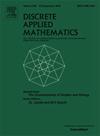寻找具有完美匹配的生成树
IF 1
3区 数学
Q3 MATHEMATICS, APPLIED
引用次数: 0
摘要
我们研究了图上两个基本结构,生成树和完美匹配的简单融合的可跟踪性。具体来说,我们考虑以下问题:给定一个边加权图,在包含完美匹配的树中找到最小权值生成树。在积极的方面,我们设计了一个简单的贪心算法,用于图是完全的(或完全二部的)并且边权最多取两个值的情况。在消极方面,即使图是完全(或完全二部)且边权最多取三个值,或者图是三次、平面和二部且边权最多取两个值时,问题也是np困难的。我们还考虑了一个有趣的变体。我们称树为强平衡树,如果在顶点集相对于树的二分划的一边,除了一个顶点以外的所有顶点都是2度,其余的一个是叶子。这一性质是树具有完美匹配的充分条件,它还具有一定的结构性质。当底层图是二部图时,强平衡生成树可以写为矩阵交,并利用这一事实设计了若干NP-hard问题的逼近算法,如旅行商问题和一类连通性增强问题。自然的问题是它在非二部图中的可溯性。作为一个否定的答案,事实证明NP-hard测试一个给定的图是否有强平衡生成树,甚至当图是次立方和平面时也是如此。本文章由计算机程序翻译,如有差异,请以英文原文为准。
Finding spanning trees with perfect matchings
We investigate the tractability of a simple fusion of two fundamental structures on graphs, a spanning tree and a perfect matching. Specifically, we consider the following problem: given an edge-weighted graph, find a minimum-weight spanning tree among those containing a perfect matching. On the positive side, we design a simple greedy algorithm for the case when the graph is complete (or complete bipartite) and the edge weights take at most two values. On the negative side, the problem is NP-hard even when the graph is complete (or complete bipartite) and the edge weights take at most three values, or when the graph is cubic, planar, and bipartite and the edge weights take at most two values.
We also consider an interesting variant. We call a tree strongly balanced if on one side of the bipartition of the vertex set with respect to the tree, all but one of the vertices have degree 2 and the remaining one is a leaf. This property is a sufficient condition for a tree to have a perfect matching, which enjoys some structural property in addition. When the underlying graph is bipartite, strongly balanced spanning trees can be written as matroid intersection, and this fact was utilized to design approximation algorithms for several NP-hard problems, e.g., the traveling salesman problem and a kind of connectivity augmentation problem. The natural question is its tractability in nonbipartite graphs. As a negative answer, it turns out NP-hard to test whether a given graph has a strongly balanced spanning tree or not even when the graph is subcubic and planar.
求助全文
通过发布文献求助,成功后即可免费获取论文全文。
去求助
来源期刊

Discrete Applied Mathematics
数学-应用数学
CiteScore
2.30
自引率
9.10%
发文量
422
审稿时长
4.5 months
期刊介绍:
The aim of Discrete Applied Mathematics is to bring together research papers in different areas of algorithmic and applicable discrete mathematics as well as applications of combinatorial mathematics to informatics and various areas of science and technology. Contributions presented to the journal can be research papers, short notes, surveys, and possibly research problems. The "Communications" section will be devoted to the fastest possible publication of recent research results that are checked and recommended for publication by a member of the Editorial Board. The journal will also publish a limited number of book announcements as well as proceedings of conferences. These proceedings will be fully refereed and adhere to the normal standards of the journal.
Potential authors are advised to view the journal and the open calls-for-papers of special issues before submitting their manuscripts. Only high-quality, original work that is within the scope of the journal or the targeted special issue will be considered.
 求助内容:
求助内容: 应助结果提醒方式:
应助结果提醒方式:


